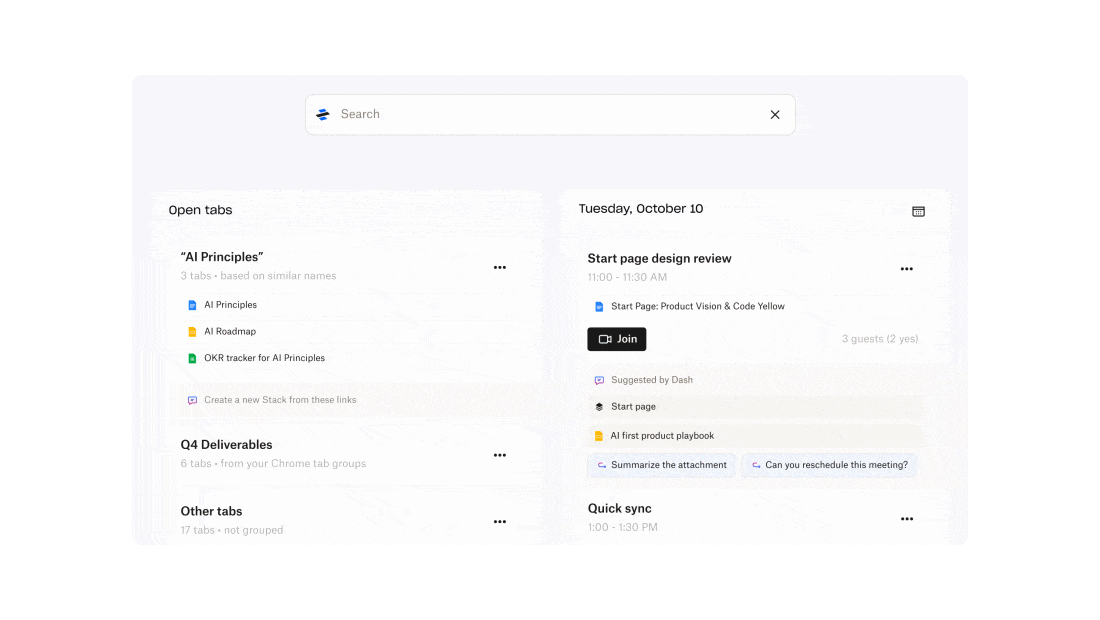In 2009, the University of California San Diego published a study that revealed Americans were processing up to 34 gigabytes of data each day, a 350 percent increase since 1980 — and that was just in leisure time alone.
In the nearly 15 years since that report, the pace of daily life and our exposure to information has only increased, both at work and at home. Meeting notifications, alerts, sifting through files to find the needed document — all of these distractions result in a lack of focus for today’s worker. In a Dropbox-sponsored study released in October 2023, Economist Impact found that the economic opportunity of addressing lost focus is nearly $1.4 trillion in the United States alone.
As Dropbox identified changing customer needs, the team uncovered a clear message: in today’s fast-paced digital world, people feel swamped with information across an array of worktools, leading to productivity bottlenecks as they navigate their days.
Dropbox Dash offers a solution. According to Marley Spector, head of product for Dropbox Dash, the new tool is a natural extension of Dropbox’s mission to design a more enlightened way of working by streamlining and simplifying the way people work.
When Dropbox’s core product offering launched in 2007, the challenge at hand was managing a desktop full of disorganized files. In launching Dash, which works across Google Drive, Microsoft 365 and Notion, Dropbox moved to become the organizing layer for the cloud — it’s now a unified platform to search and organize information efficiently across work tools.
And with powerful AI and machine learning capabilities behind the technology, Dash serves as a universal search tool for finding information or even handling routine tasks — and like any good tool, Dash continues to learn over time to better bridge the gaps between tools.
AUTOMATION ACTIVATES FOCUS
In the Economist Impact study commissioned by Dropbox, AI and automation tools were shown to have an outsized impact on how knowledge workers stay focused. Of those who reported using automation tools in their work, 79 percent were more productive and nearly 70 percent were more organized.
Built In heard from Spector about how her team built and launched Dash, as well as the many possibilities the product offers.

We built Dash so that knowledge workers could have one place to search and organize what they need to get work done across all of their work tools. This means no more searching through a dozen slide decks to find that one image you’re looking for, pinging someone to ask for the meaning of the acronym that was referred to in the meeting or keeping a bunch of tabs open because you don’t think you’ll be able to get back to them later. AI is the fabric of the product.
Dash keeps you organized, serves up relevant information like magic and proactively takes the small tasks off your plate. We have a long way to go to make the product even better, but I already rely on Dash to create my best work.
What is especially great is that Dash is not only for existing Dropbox users, but also works for those that use Google Drive, Microsoft 365 or Notion. We are looking to be the connective tissue between all of the work tools out there.
The Dash Team’s Product Principles
- Firm on user problems, flexible on solutions
- Keeping it simple
- Thinking big but starting small
- AI to augment, not replace
- Being worthy of trust
What role did you play in developing and launching Dash? What tools or technologies did your team use to build the product and why?
We started building out the vision for Dash, and I came on as the head of product and worked with our head of design to set the vision and then the strategy for bringing this product to market.
The product started with our CommandE acquisition the year before, which kickstarted our development. Dash is really Dropbox’s first AI-first product — instead of AI features being added, AI technologies are core to the product itself.
One of the biggest decisions we made from a technology standpoint earlier in the year was to move all of our app connectors and search from the client to the cloud. This means that the capabilities are available cross-platform on any device, so we were able to expand our footprint to a web app, browser extension.
What obstacles did you encounter along the way? How did you successfully overcome them?
One early obstacle was that we formed the initial team that was building this product from multiple teams across Dropbox — all of whom brought different operational rhythms and internal cultures.
For example, on the leadership team, we learned pretty quickly that daily 30-minute syncs were not scalable anymore. We have been able to replace this by coming together for in-person offsites, weekly execution check-ins across all teams and forming our own set of norms inspired by all of those different teams. My favorite value we coined was: “Be like a buffalo — run into the storm instead of away from it.”
My favorite value we coined was: ‘Be like a buffalo — run into the storm instead of away from it.’”
We are also trying to build solutions to some of the problems we faced into the Dash product, such as sharing key decisions, onboarding new team members and keeping information up to date.

What teams did you collaborate with in order to get this across the finish line?
I collaborated with everyone from product, design, engineering, data science, research, support, marketing, legal, finance, sales and more. We would not have been able to build Dash for our users without tight collaboration. From the beginning, we ensured that the whole team really had an ownership mindset — no decision should take longer than five days to make.
This wasn’t just our team; it was a full organization effort. Our first launch was a program to gather feedback from the entire organization. We created a Slack channel called “dash-feedback” for folks and established a Canny board for new feature ideas. If we don’t love Dash and use it every day internally, why would we expect anyone else to?
What values power cross-functional work at Dropbox?
What I love about our cross-functional collaboration is being candid but not combative, critical but not cynical. When things weren’t working, our communication was refreshingly direct so that we could resolve issues quickly and learn from them.
Before our initial beta launch, we heard from different people on the team, especially those who joined later, that our strategy and product plans were not clear. Nobody had the same answers when asked a question. So after the beta launch, we pulled all of the context and forward-looking product plans together into a Paper doc, to bring strategic clarity to the organization. About a week later, we had a full team offsite in San Francisco, and during one of the sessions, everyone read the full doc silently together with old-school printouts for no digital distractions. (Don’t worry, we shredded and recycled!)
After reading, we spent the next hour discussing anything that was still not clear, our concerns, what was missing, what we were most excited about and what execution challenges we needed to solve to get to our desired end state. The team’s feedback was spot on, and while some things were harder to hear than others, having these candid conversations is necessary for us to succeed. I’m really proud of our entire team and the work we do together in service of our users.







